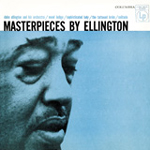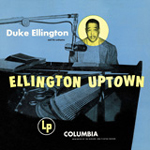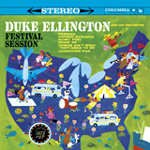| |
Duke
Ellington : 2004 Reissues (Part 1)
by Jay Collins
May 2004
Duke Ellington recorded for many labels during his lifetime, from
his early sessions backing singers or with The Washingtonians, all
the way up to the 1974 edition of the Orchestra. There are literally
hundreds, possibly thousands of sessions (Ducal fetishists will tell
you to dig through the latest edition of W.E. Timner’s marvelous
Ellington: The Recorded Music of Duke Ellington and His Sidemen).
Given today’s musical landscape, for the myriad of indies that
Duke and his contemporaries recorded for, the master recordings are
now owned by a select few. Sony/Columbia has rather considerable Duke
assets, mostly stemming from the three major periods of association:
1927-1940; 1947-1952; and 1956-1962. While the latter two periods
are often dismissed (you know those folks—those that say that
Duke’s last great period was with the Blanton-Webster Band of
1940-42), there are many gems to be found after 1950, some of which
are assessed here.
Since the majors appear to be solely in the reissue business these
days, it is interesting to note how Sony/Columbia has handled the
Maestro’s assets. While Sony did put out several releases in
1999, the year of Duke’s 100th anniversary, RCA released a monstrous
(and entirely essential) 24-disc set presenting his complete output
for the label in pristine remastering (including the aforementioned
Blanton-Webster sides and a mountain of alternate/rare tracks). Not
to overstress the point, but Sony could have done a lot better than
they did. Of course, they did release some worthwhile titles (like
the legendary Newport set featuring Paul Gonsalves’ famous
multi-chorus solo on “Diminuendo and Crescendo In Blue”),
but nothing that could be deemed essential. The sad thing is that
the remainder of the material continues to sit in the vaults collecting
dust—most criminally, the material from the Okeh era with its
dated remastering (which includes some of Duke’s most classic
material with Bubber Miley) and the late 30’s recordings.
So, another anniversary is upon us: The 30th anniversary of Duke’s
passing. Without question, these new reissues (with more to come)—Masterpieces
By Ellington, Ellington Uptown and Festival Session—are
an extremely welcome occasion and hopefully a sign that the catalog
will come back into print with top-notch mastering. Based on the results
heard here, there is a great deal of hope.
After making some of the most remarkable music of his career (and
Jazz history), Ellington came back to Columbia in 1947 and stuck around
until 1952. Technologically speaking, these were Duke’s last
78’s and his first recording via a magnetic tape. There are many
highlights from the period including both new compositions (who can
really resist Ray Nance’s vocal on “You’re Just An
Old Antidisestabishmentarianismist”? ) and revamped classics.
The biggest blow of the period, for Duke at least, was the loss of
three extremely important members of the band in 1951: Johnny Hodges,
Lawrence Brown and Sunny Greer. But we are getting ahead of ourselves.
 The
title Masterpieces By Ellington may seem a bit hyperbolic,
especially when you are referring to a composer who wrote anywhere
from arguably 25-75 certifiable masterpieces (some not as well known
as they should be, mind you, and depending on your level of obsessiveness),
but in terms of this particular record, the title is apt. Columbia’s
introduction of the long playing record in 1948 lead to the idea that
Duke should take advantage of the new medium by recording “concert”
arrangements of some of his most known pieces. Thus, the gems, “Mood
Indigo”, “Sophisticated Lady”, and “Solitude”
are given extended performances alongside a new piece, “The Tattooed
Bride”, the latter of which makes its first (and last) studio
appearance. The record begins with a luscious 15-minute version of
“Mood Indigo” that features gorgeous smoke from the soloists,
whether initial sputtering Procope statements or the smooth flow of
Johnny Hodges and later, the Webster-influenced lines of Paul Gonsalves.
On both “Mood Indigo” and the next piece, “Sophisticated
Lady”, vocalist Yvonne Lanauze takes an easygoing approach with
a smooth-as-silk delivery that keeps the mood warm. The latter is
treated with typical beauty, a Carney spotlight, here on bass clarinet
during the opening segments, as well as lyrical work from trumpeter
Shorty Baker. The “Tattooed Bride” is a feature for Jimmy
Hamilton’s marvelous clarinet work, though the band takes it
out in a typically sophisticated manner. Finally, as for the original
program, “Solitude” is a precious feature for all of the
main soloists. For what it’s worth, the three bonus tracks are
good fun, but don’t really increase the value of this already
sublime record. The
title Masterpieces By Ellington may seem a bit hyperbolic,
especially when you are referring to a composer who wrote anywhere
from arguably 25-75 certifiable masterpieces (some not as well known
as they should be, mind you, and depending on your level of obsessiveness),
but in terms of this particular record, the title is apt. Columbia’s
introduction of the long playing record in 1948 lead to the idea that
Duke should take advantage of the new medium by recording “concert”
arrangements of some of his most known pieces. Thus, the gems, “Mood
Indigo”, “Sophisticated Lady”, and “Solitude”
are given extended performances alongside a new piece, “The Tattooed
Bride”, the latter of which makes its first (and last) studio
appearance. The record begins with a luscious 15-minute version of
“Mood Indigo” that features gorgeous smoke from the soloists,
whether initial sputtering Procope statements or the smooth flow of
Johnny Hodges and later, the Webster-influenced lines of Paul Gonsalves.
On both “Mood Indigo” and the next piece, “Sophisticated
Lady”, vocalist Yvonne Lanauze takes an easygoing approach with
a smooth-as-silk delivery that keeps the mood warm. The latter is
treated with typical beauty, a Carney spotlight, here on bass clarinet
during the opening segments, as well as lyrical work from trumpeter
Shorty Baker. The “Tattooed Bride” is a feature for Jimmy
Hamilton’s marvelous clarinet work, though the band takes it
out in a typically sophisticated manner. Finally, as for the original
program, “Solitude” is a precious feature for all of the
main soloists. For what it’s worth, the three bonus tracks are
good fun, but don’t really increase the value of this already
sublime record.
 Ellington
Uptown came next but was notable for the absence of many key players,
especially Hodges. Despite the loss, the band doesn’t seem to
miss them much, as they sound refreshed, particularly by the presence
of drummer (and composer) Louis Bellson. From the opening moments
of the record, Bellson kicks hard on his drum-centric “Skin Deep”.
Why Bellson’s blitzkrieg single-stroke rolls and booming double
bass drum work (a decade or more before rock drummers began to add
another bass drum to their arsenals) isn’t mentioned as one of
the greatest drumming performances of all time is a mystery. The “concert
arrangement” concept continues here too, with versions of classics
like “The Mooch” and of course, “Take The ‘A’
Train”. The latter is known by many for Betty Roché’s
sassy and cool vocal, complete with a Bop scat chorus or two. Duke's
piano work, Bellson’s whisking brushwork and Gonsalves’
soaring tenor work also add spice to this old warhorse. Considerable
beauty is also present too, seen through the symphonic colors of “Tone
Parallel Of Harlem”, the record’s focal point that demonstrates
yet again the depth of Duke and Strayhorn’s compositional and
arranging prowess. As for the original program’s finale, “Perdido”,
it is a smoker. Check out Duke’s boogie-woogie intro and later
in the piece, the brass’ fours-trading amidst a supremely swinging
tempo. Ellington
Uptown came next but was notable for the absence of many key players,
especially Hodges. Despite the loss, the band doesn’t seem to
miss them much, as they sound refreshed, particularly by the presence
of drummer (and composer) Louis Bellson. From the opening moments
of the record, Bellson kicks hard on his drum-centric “Skin Deep”.
Why Bellson’s blitzkrieg single-stroke rolls and booming double
bass drum work (a decade or more before rock drummers began to add
another bass drum to their arsenals) isn’t mentioned as one of
the greatest drumming performances of all time is a mystery. The “concert
arrangement” concept continues here too, with versions of classics
like “The Mooch” and of course, “Take The ‘A’
Train”. The latter is known by many for Betty Roché’s
sassy and cool vocal, complete with a Bop scat chorus or two. Duke's
piano work, Bellson’s whisking brushwork and Gonsalves’
soaring tenor work also add spice to this old warhorse. Considerable
beauty is also present too, seen through the symphonic colors of “Tone
Parallel Of Harlem”, the record’s focal point that demonstrates
yet again the depth of Duke and Strayhorn’s compositional and
arranging prowess. As for the original program’s finale, “Perdido”,
it is a smoker. Check out Duke’s boogie-woogie intro and later
in the piece, the brass’ fours-trading amidst a supremely swinging
tempo.
As for the two extra long-form pieces tacked on to Uptown,
they do add depth, despite not necessarily falling in line thematically.
First, the “Controversial Suite” is Duke’s look at
the state of the music in December of 1951 that highlights this band’s
versatility. The first part, “Before My Time”, is a take
on New Orleans and perhaps an answer to those straw-hat modeling revivalists,
while the second part, “Later”, is Duke’s look at “modern
Jazz”, featuring rather forward-looking solos from both Gonsalves
and Duke himself. Finally, the “Liberian Suite”, presents
a previously orphaned piece (during the CD era) from 1947 (whoa!:
Brown, Hodges and Greer are back!). The first section, “I Like
The Sunrise”, is simply sublime due to Al Hibbler’s luminous
vocal. The focus of the rest of the “Dances” is on exotic
moods mixed with a healthy dose of swing. The highlights include Al
Sears’ gruff wails on “Dance No. 1”, Tyree Glenn’s
glittering vibes on “Dance No. 2” and Carney’s ebullient
work on the tango of “Dance No. 3”. This record is one for
the desert island and its value is increased by the inclusion of the
two remarkable long-form suites.
 Duke
left Columbia and eventually returned after recording for Capitol
for a stretch (with the Company’s goal being commercial success—although
the Reprise era wasn’t too far away either). 1959 saw the recording
of Festival Session, not a stinker by any stretch, but not
even close to the level of the previous two records. This is simply
a band having fun and trying to capture the vibe from its road work
(you’ll even hear Duke’s announcements to the “audience”—it
was recorded in a NYC studio). The soloists, of course, are still
aplenty and Duke makes good use of their talents. Right off the bat,
the band is smoking on the Juan Tizol penned, Clark Terry feature,
“Perdido” (yes, heard again). Paul Gonsalves has his run
with “Copout Extension” that treads rather closely, seemingly
ripping himself off, in the mode of “Diminuendo and Crescendo
In Blue”. For the drum-heads, the three part “Duael Feul”
should do the trick, an excursion for two drummers, Jimmy Johnson
and Sam Woodyard, and the rest of the band. The grand finale, and
a new track, “Jam With Sam”, ends the program joyously,
with an absolutely stratospheric solo from Cat Anderson that stretches
the boundaries of the human ear. Certainly, this session is far less
memorable than others, but shows a tight band, in good spirits, with
plenty to say. Duke
left Columbia and eventually returned after recording for Capitol
for a stretch (with the Company’s goal being commercial success—although
the Reprise era wasn’t too far away either). 1959 saw the recording
of Festival Session, not a stinker by any stretch, but not
even close to the level of the previous two records. This is simply
a band having fun and trying to capture the vibe from its road work
(you’ll even hear Duke’s announcements to the “audience”—it
was recorded in a NYC studio). The soloists, of course, are still
aplenty and Duke makes good use of their talents. Right off the bat,
the band is smoking on the Juan Tizol penned, Clark Terry feature,
“Perdido” (yes, heard again). Paul Gonsalves has his run
with “Copout Extension” that treads rather closely, seemingly
ripping himself off, in the mode of “Diminuendo and Crescendo
In Blue”. For the drum-heads, the three part “Duael Feul”
should do the trick, an excursion for two drummers, Jimmy Johnson
and Sam Woodyard, and the rest of the band. The grand finale, and
a new track, “Jam With Sam”, ends the program joyously,
with an absolutely stratospheric solo from Cat Anderson that stretches
the boundaries of the human ear. Certainly, this session is far less
memorable than others, but shows a tight band, in good spirits, with
plenty to say.
Considering the above, Masterpieces and Uptown are more
essential than Festival Session; however, the band was certainly
playing on a high level, one which would continue for arguably another
5-10 years. Now that Sony/Columbia has released these gems, let’s
hope that there is more on the horizon. We never need an anniversary
for more Ducal adventures.
|
|
|
|
|

